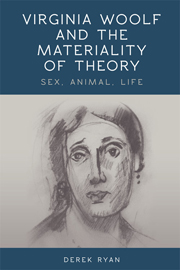Book contents
- Frontmatter
- Contents
- Acknowledgements
- Abbreviations
- Introduction: Virginia Woolf and the Materiality of Theory
- 1 Materials for Theory: Digging Granite and Chasing Rainbows
- 2 Sexual Difference in Becoming: A Room of One's Own and To the Lighthouse
- 3 Queering Orlando and Non/Human Desire
- 4 The Question of the Animal in Flush
- 5 Quantum Reality and Posthuman Life: The Waves
- Bibilography
- Index
5 - Quantum Reality and Posthuman Life: The Waves
Published online by Cambridge University Press: 05 September 2013
- Frontmatter
- Contents
- Acknowledgements
- Abbreviations
- Introduction: Virginia Woolf and the Materiality of Theory
- 1 Materials for Theory: Digging Granite and Chasing Rainbows
- 2 Sexual Difference in Becoming: A Room of One's Own and To the Lighthouse
- 3 Queering Orlando and Non/Human Desire
- 4 The Question of the Animal in Flush
- 5 Quantum Reality and Posthuman Life: The Waves
- Bibilography
- Index
Summary
‘This table […] about to undergo an extraordinary transformation’
(W 97)In The Phantom Table (2000) Ann Banfield sets Woolf's ‘table’ as the meeting place for her writings and the philosophy of Bertrand Russell and the Cambridge Apostles. As ‘the paradigmatic object of knowledge’ in the tradition of British Empiricism, the table is ‘planted squarely in the centre of Woolf's novelistic scenery'; a place where Woolf can gather together her thoughts on ‘subject and object and the nature of reality’ (TL 28) and, according to Banfield, a place that aligns Woolf with Russell's theory of knowledge. In a recent article Timothy Mackin also discusses Woolf's tables as central to her engagement with philosophy, but argues that she is not, like Russell, ‘trying to provide the foundation for a realist epistemology’ so much as she is attempting to work through a relation between internal emotions and the external world. Whilst these studies provide important insights into Woolf's philosophical engagement with her own contemporaries, I am interested in aspects of Woolf's exploration of epistemology and ontology, internal and external, subject and object, life and matter, which extend beyond Russell's theory of knowledge and Bloomsbury philosophy and can be thought about more broadly through what Karen Barad refers to in Meeting the Universe Halfway as a quantum ‘philosophy-physics’ born out of Planck's discovery of quanta in December 1900 (did human character change then, perhaps?), Bohr's atom (1913) (and Bohr is the central focus for Barad), Einstein's special theory (1905) and general theory (1916) of relativity, and the work on wave and particle theories of Heisenberg, de Broglie, and Schrödinger amongst others.
- Type
- Chapter
- Information
- Virginia Woolf and the Materiality of TheorySex, Animal, Life, pp. 171 - 202Publisher: Edinburgh University PressPrint publication year: 2013

